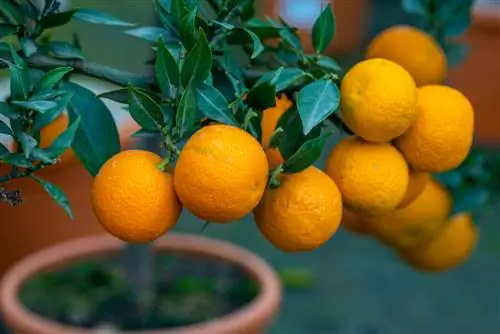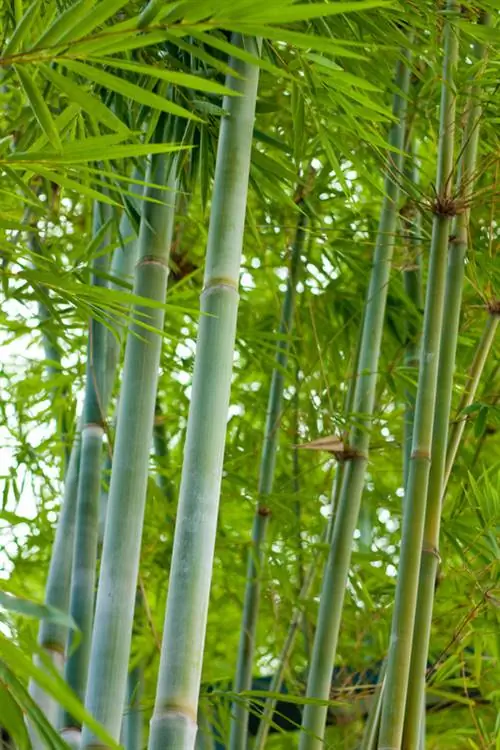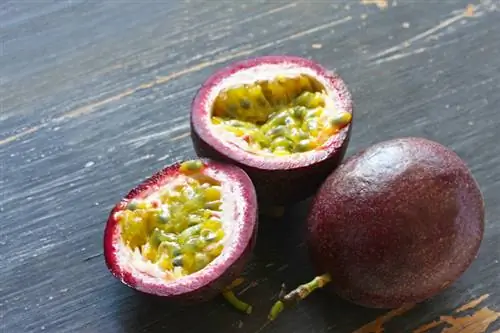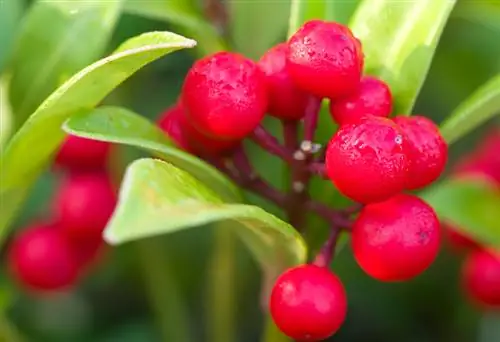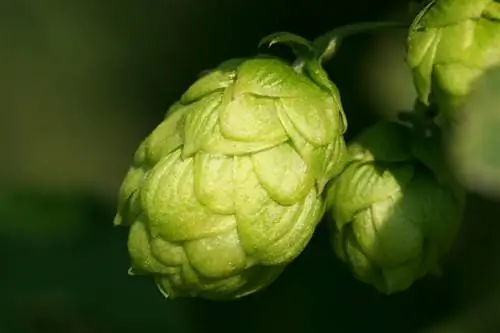- Author admin [email protected].
- Public 2023-12-16 16:46.
- Last modified 2025-06-01 06:02.
Read compact information about the Chinotto fruit in the profile here. Benefit from informative information about the popular Chinotto drink with lots of tips for a refreshing enjoyment.

What is Chinotto and what is it used for?
Chinotto (Citrus myrtifolia) is a citrus plant with tangerine-shaped, bitter fruits and fragrant, white flowers. It is native to Southeast Asia and is cultivated as a container plant. Chinotto is also used for a refreshing Italian drink that tastes slightly bitter, mildly fruity and aromatic.
Profile
- Scientific name: Citrus myrtifolia var. Citrus aurantium
- Synonym: soft drink
- Genus: Citrus plants (Citrus)
- Growth type: tree or shrub
- Growth height: 80 cm to 200 cm
- Origin: Southeast Asia, China
- Fruit: tangerine-shaped
- Taste: bitter
- Flower: white, fragrant
- Flowering time: blooming several times
- Leaf: triangular, evergreen, fragrant
- Winter hardiness: not hardy
- Use: potted plant, drink, treat
Fruit
Chinotto trees are among the most beautiful citrus plants that spread a Mediterranean flair on balconies and terraces north of the Alps. Evergreen, attractive leaves sit like roof tiles, overlapping each other on the tightly upright branches. In spring, 2 cm large, white flowers unfold in several bursts. Leaves and flowers smell aromatic and make you look forward to the fruits. Older specimens bear flowers and fruit at the same time. The following characteristics characterize a Chinotto fruit:
- Size and shape: similar to a tangerine or small bitter orange
- Color: orange
- Arrangement: individually or in groups
- Flesh: dry, with or without seeds
- Taste: bitter to bitter-sweet
The chinotto fruit is not suitable for fresh consumption. This changes as soon as you squeeze freshly harvested fruit and enjoy the juice, as the following video shows:
Video: This is what the chinotto fruit tastes like
Ingredients soft drink
The term Chinotto is usually used to describe a soft drink. This raises the question about the ingredients. The following table provides an overview:
| Ingredients | per 100 ml | per 200 ml bottle | corresponds to |
|---|---|---|---|
| Condensing value | 56 kcal (238 kJ) | 127 kcal (538 kJ) | 6 % |
| Carbohydrates | 14 g | 28 g | 11 % |
| of which sugar | 14 g | 28 g | 11 % |
| Fiber | less than 0.5 g | 1 g | 1 % |
| Fat | less than 0.5 g | 1 g | 1 % |
Chinotto effervescent also contains: carbon dioxide, a pinch of s alt, lemon juice and various plant extracts. You can read interesting background information about the Chinotto drink in the following section.
Chinotto drink
The Chinotto soft drink was once touted as Italy's answer to Coca-Cola. The bitter effervescence was not able to achieve worldwide fame. After all, Chinotto has established itself as a trendy drink. The leading company is the Italian brand Sanpellegrino, which has been exporting Chinotto all over the world since the 1980s. These properties make the Chinotto drink an export hit:
- Taste: slightly bitter, mildly fruity, aromatic due to the addition of natural plant extracts
- Effect: sparkling-refreshing with little carbon dioxide
- Color: brown
- Benefits: thirst-quenching, low in calories, without alcohol or caffeine
- Usage: pure as a thirst quencher, in rum drinks as a cola replacement, with vermouth as a digestif, with gin or bourbon as a long drink.
Chinotto-Brause gets its brown color from the addition of caramel as a natural sweetener. It is not revealed which plant extracts create the distinctive aroma. After all, well-known manufacturers such as Sanpellegrino or Lurisia reveal that more than 20 different herbs combine to create a harmonious enjoyment experience.
processing chinotto
Candied Chinotto are another export hit from Italy. The boom was triggered when the first factory for the delicacy opened in Liguria. Chinotto jam made from fresh fruit is very popular, as a much sought-after souvenir from a holiday in Italy on the Ligurian coast. A sip of Chinotto lemonade from Lurisia brings back memories of relaxing days on the Mediterranean. You can prepare all three delicacies yourself. Get inspired by these recipes:
Candied chinotto
The entire process takes five days. To prepare, the fresh chinottos are washed. The thick shell is pierced with a needle. Cut the fruit into bite-sized pieces, no more than 1.5 cm to 2 cm in size. Follow these steps:
- Stir sugar into the boiling water in a ratio of 1:1 (500 g of sugar per 500 ml of water)
- Stir until the sugar is completely dissolved and allow to cool slightly
- Put the fruits in a pot and pour warm sugar water over them (the fruits must be covered)
- Cover the pot and let it stand for a day
- After 24 hours, drain the fruit and bring the sugar solution to the boil
- Pour lukewarm sugar water over the fruit again and let it sit covered for a day
- Repeat the process for two more days
- On the 5th day, drain the candied fruit in the sieve
- Dry on a wire rack
Traditionally, candied chinotto are marinated in Maraschino liqueur.
Chinotto Jam - Recipe
To prepare Chinotto jam you need 500 grams of ripe organic fruit, 500 grams of sugar, a saucepan, a blender and screw-top jars. This delicious recipe is so easy:
- Wash the chinottos in hot water, cut them into wedges and remove the seeds
- Cut the wedges into strips, reserving the juice
- Put the chinotto strips with juice into the pot and fill with water
- Bring to the boil, simmer for 60 minutes until the fruit strips are soft
- Crush fruit strips with a hand blender
- Weigh the fruit puree and mix with sugar in a ratio of 1:1
Boil the chinotto-sugar mixture for 5 to 7 minutes, stirring constantly. Fill the hot jam into screw-top jars, close them tightly and let them cool upside down.
Chinotto Lemonade - Recipe
Write down on the list of ingredients: 3 ripe organic chinotto fruits, 20 ml lemon juice, 0.5 l water and 400 g sugar. How to Make Your Own Chinotto Lemonade:
- Wash chinottos
- Grate a little from the peel
- Halve and squeeze the fruits
- Pour juice into a container
- Bring the water to the boil and stir in the sugar
- Stir in the chinotto peel and lemon juice
- Add chinotto juice, stirring constantly
- Pour the syrup into a bottle and let it steep for a day
Serve the Chinotto lemonade in style with San Pellegrino mineral water. Pour a dash of syrup into a glass and top up with still or sparkling water.
Excursus
Chinotto means 'Little Chinese'
Chinotto plants are native to Southeast Asia, especially widespread in China. Legend has it that the first trees arrived on the Ligurian coast in the 17th century. The name Chinotto refers to this event as the Italian diminutive of 'Chinese'.
Caring for Chinotto trees
Have courage to purchase a pretty Chinotto tree. The care is easy to manage even for the inexperienced hand if you follow the following tips:
Watering and fertilizing
As a sun worshiper, the Chinotto plant is surprisingly economical to use. Water the plant when the substrate is noticeably dry down to the deeper layers. You can either use normal tap water or collected rainwater as irrigation water. From May to August, add a liquid citrus fertilizer to the water according to the manufacturer's instructions.
Wintering
You can overwinter a Chinotto tree like a lemon tree. Ideally, preparation begins in autumn. How to do it right:
- Watering more sparingly in autumn
- Place the chinotto pot on wood in front of the protective house wall
- Put away before the first frost
- Winter bright and cool at temperatures between 5° and 12° Celsius
- Suitable winter quarters: cold winter garden, bright staircase, greenhouse with frost monitor
In winter quarters, the water requirement drops to a minimum. Experience has shown that a Chinotto tree does not need any water at all between November and April. Waterlogging is the most common cause of failed wintering. Only water the plant when the substrate is half dry. A useful tool is a moisture indicator (€39.00 at Amazon), whose long probe in the substrate determines whether there is a need for watering or not.
Cutting
You should not cut back your Chinotto tree. Given the slow growth, you will happily notice every centimeter of growth. Professional pruning care is limited to occasional thinning out of dead branches. The best time is in February, when the winter rest is coming to an end. If a bunch of branches stick out of the crown, there is no reason why there should be no local pruning. For the perfect cut, place the scissors just above a leaf, a bud or a sleeping eye.
Popular varieties
Different types of Chinotto can be discovered in specialist shops with individual attributes:
- Canaliculata: Citrus aurantium hybrid with ribbed citrus fruits.
- Chinotto 'Grande': refined as a standard tree on a 130 cm high trunk.
- Crispifolia: worth seeing citrus plant with elegantly wavy leaves.
- Boxwood Leaf Chinotto: Rarity with rounded leaves.
FAQ
Is eating chinotto allowed during pregnancy?
Chinotto is a safe soft drink during pregnancy. Hazardous substances such as alcohol or caffeine are missing. In contrast to tonic water or bitter lemon, the brown soda does not contain quinine. This at least applies to trustworthy brands such as Sanpellegrino, Lurisia, Neri or Polara. Be careful with no-name products that do not contain real Chinotto fruit juice, but consist solely of sugar water and artificial flavorings.
Is chinotto soda he althy?
Chinotto is a he althy thirst quencher for the whole family. The main ingredient of the soda is the vitamin-rich citrus fruit juice. A look at the other ingredients reveals that it is a non-alcoholic soft drink without caffeine or quinine. Instead of granulated sugar, caramel gives the drink a pleasant sweetness and brown color. With 56 calories per 100 milliliters, the energy value is comparable to fruit juice or whole milk.
Which location is right for Chinotto trees?
The ideal location is full sun, warm and protected from the wind. From spring to autumn, your Chinotto tree prefers to spend time on the south-facing balcony. Every minute of sunshine increases the sweetness of the citrus fruit. When choosing a location, please make sure that no shadow falls on the citrus plant. Ideally, you should place the pot on a platform. Before the first frost, move the Chinotto tree into the bright winter quarters with 5° to 12° Celsius.
Which fertilizer is suitable for Chinotto plants?
A citrus fertilizer with an ideal NPK composition of 20+5+15 is recommended for nutrient supply. The fertilizer should also contain trace elements such as iron, magnesium, zinc, manganese and copper. Citrus fertilizer is always administered with irrigation water from May to August. To ensure perfect absorption of the nutrients, please water with clear water before and after.

